Input interpretation

formic acid
Chemical names and formulas
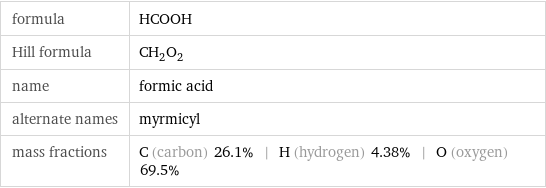
formula | HCOOH Hill formula | CH_2O_2 name | formic acid alternate names | myrmicyl mass fractions | C (carbon) 26.1% | H (hydrogen) 4.38% | O (oxygen) 69.5%
Lewis structure
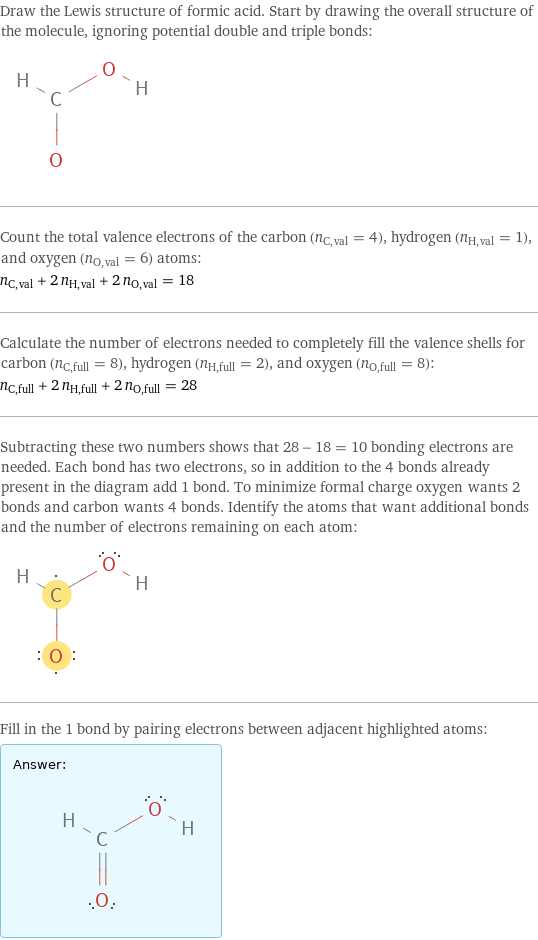
Draw the Lewis structure of formic acid. Start by drawing the overall structure of the molecule, ignoring potential double and triple bonds: Count the total valence electrons of the carbon (n_C, val = 4), hydrogen (n_H, val = 1), and oxygen (n_O, val = 6) atoms: n_C, val + 2 n_H, val + 2 n_O, val = 18 Calculate the number of electrons needed to completely fill the valence shells for carbon (n_C, full = 8), hydrogen (n_H, full = 2), and oxygen (n_O, full = 8): n_C, full + 2 n_H, full + 2 n_O, full = 28 Subtracting these two numbers shows that 28 - 18 = 10 bonding electrons are needed. Each bond has two electrons, so in addition to the 4 bonds already present in the diagram add 1 bond. To minimize formal charge oxygen wants 2 bonds and carbon wants 4 bonds. Identify the atoms that want additional bonds and the number of electrons remaining on each atom: Fill in the 1 bond by pairing electrons between adjacent highlighted atoms: Answer: | |
3D structure

3D structure
Basic properties

molar mass | 46.025 g/mol phase | liquid (at STP) melting point | 8.3 °C boiling point | 100.5 °C density | 1.22 g/cm^3 solubility in water | miscible dielectric constant | 58.5
Hydrophobicity and permeability properties

experimental LogP hydrophobicity | -0.54 predicted LogP hydrophobicity | -0.46 predicted LogS | 1.02
Basic drug properties

approval status | experimental | small molecule drug categories | antibacterial agent
Liquid properties (at STP)
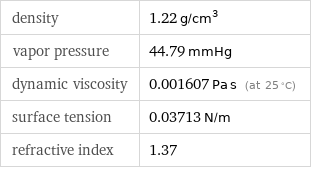
density | 1.22 g/cm^3 vapor pressure | 44.79 mmHg dynamic viscosity | 0.001607 Pa s (at 25 °C) surface tension | 0.03713 N/m refractive index | 1.37
Units

Thermodynamic properties
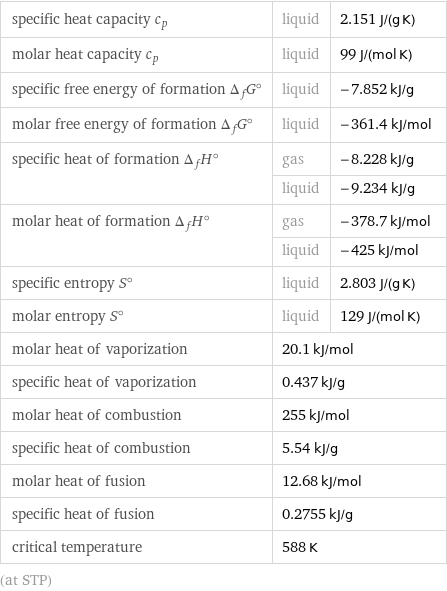
specific heat capacity c_p | liquid | 2.151 J/(g K) molar heat capacity c_p | liquid | 99 J/(mol K) specific free energy of formation Δ_fG° | liquid | -7.852 kJ/g molar free energy of formation Δ_fG° | liquid | -361.4 kJ/mol specific heat of formation Δ_fH° | gas | -8.228 kJ/g | liquid | -9.234 kJ/g molar heat of formation Δ_fH° | gas | -378.7 kJ/mol | liquid | -425 kJ/mol specific entropy S° | liquid | 2.803 J/(g K) molar entropy S° | liquid | 129 J/(mol K) molar heat of vaporization | 20.1 kJ/mol | specific heat of vaporization | 0.437 kJ/g | molar heat of combustion | 255 kJ/mol | specific heat of combustion | 5.54 kJ/g | molar heat of fusion | 12.68 kJ/mol | specific heat of fusion | 0.2755 kJ/g | critical temperature | 588 K | (at STP)
Chemical identifiers
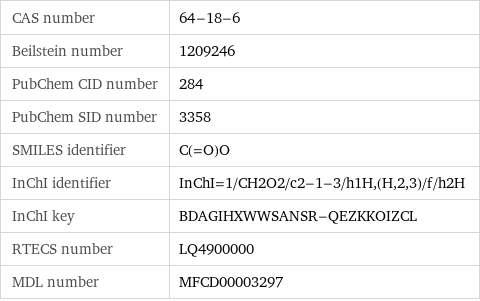
CAS number | 64-18-6 Beilstein number | 1209246 PubChem CID number | 284 PubChem SID number | 3358 SMILES identifier | C(=O)O InChI identifier | InChI=1/CH2O2/c2-1-3/h1H, (H, 2, 3)/f/h2H InChI key | BDAGIHXWWSANSR-QEZKKOIZCL RTECS number | LQ4900000 MDL number | MFCD00003297
NFPA label

NFPA label

NFPA health rating | 3 NFPA fire rating | 2 NFPA reactivity rating | 0
Safety properties
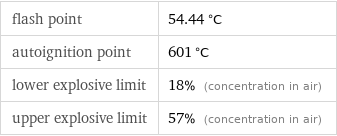
flash point | 54.44 °C autoignition point | 601 °C lower explosive limit | 18% (concentration in air) upper explosive limit | 57% (concentration in air)

DOT hazard class | 8 DOT numbers | 1779
Toxicity properties

odor | pungent odor threshold | 49 ppm lethal dosage | 1100 mg/kg (oral dose for rats) threshold limit value | 5 ppmv
Units
